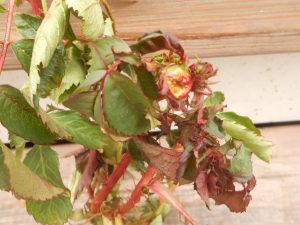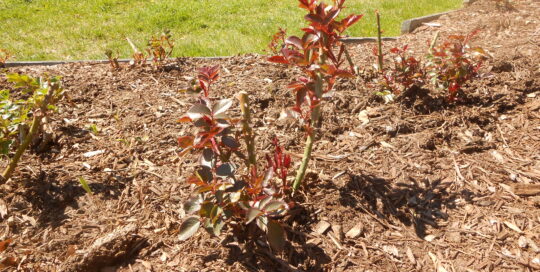An Unwelcome Visitor: I Found RRD in My Roses
Views: 3916

Things have been a little slow in the garden this spring. I am thrilled that we are getting sufficient rain so far this year. However, I get a little pushed when we have extended cloudy periods where there is no precipitation. It means that all the new growth on the roses is beautiful, rich burgundy and succulent, but then there is a problem when the sun does come out. I would say our temps have been averaging in the low 60’s, and then last Wednesday, Thursday, and Friday, all hell broke loose! All three days broke forth with full sun and temperatures between 95-99 degrees! There was also a hot, dry wind that felt like a blast furnace.
We were suffering and so were all the plants outside. Some of my roses responded by yellowing and dropping lower leaves. My big hostas in my shade garden burned badly from the heat and wind and some of the leaves look like giant potato chips. The big maple tree behind our garage looks like the lower third of the tree was hit by a blow torch. Freakish, destructive and sad…and there was nothing I could do about it. Since then, the temps have moderated and we’re just left with the mess.
Fertilizing
Tuesday and Wednesday were great this week, so I have been continuing with my fertilization program. I have beautiful farm soil here. For the last few years, I have been using Osmocote for feeding my roses and perennials. It lasts for the whole summer, and as a time-release fertilizer, it releases nutrients to my plants every time it rains or I irrigate my gardens. I love spring gardening. Pruning time gives me an opportunity to shape my bushes. Feeding time, a few weeks later, gives me a chance to see how well things are growing. I spend time with all my roses every day. First of all because I love them, and secondly, because I am always on the outlook for pests and diseases.
RRD!
Earlier this week, I was walking by my ‘Macy’s Pride’ rosebush and saw something that I hated to see: Rose Rosette Disease (or RRD). I pruned the sick growth off (pictured above) and decided to give it a couple of days to see how the rose was doing. This is a big, always before healthy, rose in my Rose Forest Garden.
RRD is vectored by a tiny little mite called an eriophyid mite. It makes our regular garden mites look like buffalo, it is so small. The little critters spin silk and balloon in the wind like little spiderlings, and when they land on a rose and begin to feed, they pass the RRD virus into the vascular system of the plant. Their preference is r. multiflora, the wild white roses that are everywhere and are considered a noxious weed. I first spotted RRD during my tenure at the Elizabeth Park Rose Garden back in 2009, and that was the first time RRD was reported in Connecticut. What an awful spot to first find this stuff, America’s oldest municipal rose garden!
Miticide to the rescue
The rest of the time I worked at the park, I made sure we sprayed the roses with a miticide once a month. These mites have been around for a long time, so they have developed immunity to a lot of miticides. So, my choice was Floramite alternating with Forbid, newer varieties. Both of these products kill all phases of the mite, from egg to adult. Both these products last systemically for 21 days.
When we spotted RRD on a hedgerow of r. multiflora at the bottom of our hill a few years ago, I decided to alternate spraying all my roses with these two products every three weeks. I know RRD is around my town of Windsor, and whenever I spot it, I alert our Ag Station and our Town Hall. Last summer, my mom got sick in the middle of July and she flew to Heaven in the end of August. There was no time to spray, and I guess that’s when ‘Macy’s Pride’ became infected.
Roses grow really fast this time of year. I checked the rose in question again on Wednesday evening. I know there are no mites on it, because it has been sprayed with Forbid. But, unfortunately, I found more ugly, red, distorted foliage. It’s coming from the base of the plant which means the entire plant is diseased. There is nothing left to do but rogue the plant out, pull out all the roots, put it in a black plastic bag, and take it to the dump. RRD is not the end of the world. If you find it in your garden, bring samples to your Ag Station so they can track it in your area. Then, take the plant out. You and your other roses will be glad you did.
Meet Marci Martin
Marci Martin has loved roses for as long as she can remember. From the time she was a little girl, she was fascinated with how…
Marci's Recent Posts

March: An Early Start in the Rose Garden This Year








